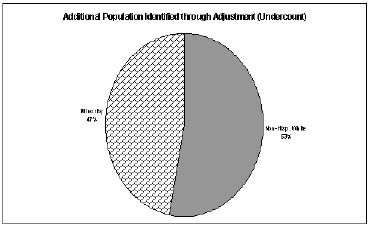State-by-State Analysis: North Carolina
The
1990 undercount and its demographic composition
As
indicated in Table 1, the percentage undercount of 1.9 percent in North
Carolina was higher than the national average of 1.6 percent and resulted
in a net numerical undercount of 125,930 persons, seventh highest in the
nation. For non-Hispanic whites, Table 1 indicates, the undercount percentage
was 1.3 percent as compared to 3.6 percent for members of minority groups.
As indicated in Table 2 and the summary Chart below, these differentials
between whites and minorities resulted in an undercounted population with
a much greater minority group percentage than the state's total population.
Minorities comprised 25 percent of the state's uncorrected population, compared
to 47 percent of the state's undercounted population. In numerical terms,
the undercount consisted of 66,340 non-Hispanic whites and 59,590 members
of minority groups. In North Carolina, as in Georgia and Virginia, the minority
population consists primarily of non-Hispanic blacks. In North Carolina,
87 percent of minority group members are African-Americans, 5 percent are
Hispanic, and 8 percent are members of other minority groups.


Implications
of 1990 Census adjustment for minority voter opportunities
The
use of corrected data in North Carolina for the post-1990 redistricting
would have had the potential to enhance minority voter opportunities in
the plans drawn for the State Senate and State House. In the North Carolina
State Senate, the use of corrected data would have enhanced minority voter
opportunities by increasing the baseline of majority-minority districts
against which the next redistricting plan will be measured. State Senate
District 7, located in the southeastern part of the state, includes a minority
population of 48.6 percent. However, application of the corrected data for
1990 demonstrates that the population of this District is more accurately
measured at 49.0 percent. The use of corrected data for six senate districts
surrounding Senate District 7 also reveals a sufficient number of additional
persons, including a substantial percentage of minorities, so that State
Senate District 7 might have been drawn to include a higher minority percentage
than the current district, with the potential to increase this district
to the 50 percent mark. The corrected data in surrounding districts identifies
some 16,000 additional persons, nearly half minority (some 7,900). This
additional population was more than would have been needed to meet one-person,
one-vote requirements in this region, given that the use of adjusted data
would increase the size of an ideal State Senate district by some 2,500
persons, from some 132,600 to 135,100.
The
use of corrected rather than uncorrected Census data in North Carolina would
have had an impact on State House districts as well. In the North Carolina
State House, there are no districts with minority percentages approaching
50 percent. However, there are several districts with minority populations
close to or greater than 40 percent minority. The district with the greatest
potential to have had a substantially augmented minority population is House
District 6 in north-eastern North Carolina (37.8 percent minority, primarily
black). The corrected data in seven surrounding districts identifies some
9,100 additional persons, including some 6200 minority group members (68
percent). This additional population was more than would have been needed
to meet one-person, one-vote requirements in this region, given that the
use of adjusted data would increase the size of an ideal State House district
by only 1,049 persons, from 55,239 to 56,288.





